2014 BMW 428I COUPE oil temperature
[x] Cancel search: oil temperaturePage 73 of 236
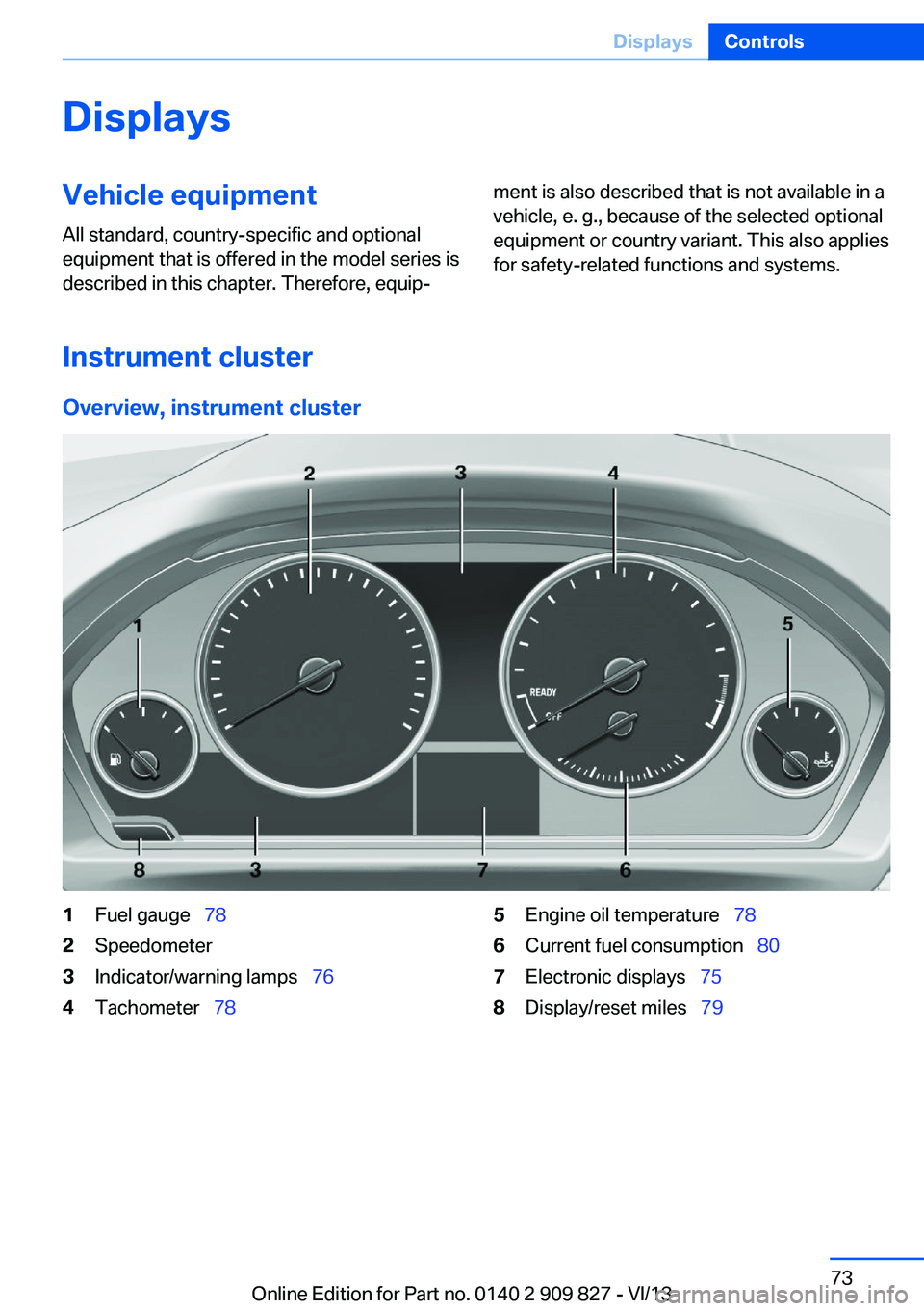
DisplaysVehicle equipmentAll standard, country-specific and optional
equipment that is offered in the model series is
described in this chapter. Therefore, equip‐ment is also described that is not available in a
vehicle, e. g., because of the selected optional
equipment or country variant. This also applies
for safety-related functions and systems.
Instrument cluster
Overview, instrument cluster
1Fuel gauge 782Speedometer3Indicator/warning lamps 764Tachometer 785Engine oil temperature 786Current fuel consumption 807Electronic displays 758Display/reset miles 79Seite 73DisplaysControls73
Online Edition for Part no. 0140 2 909 827 - VI/13
Page 74 of 236
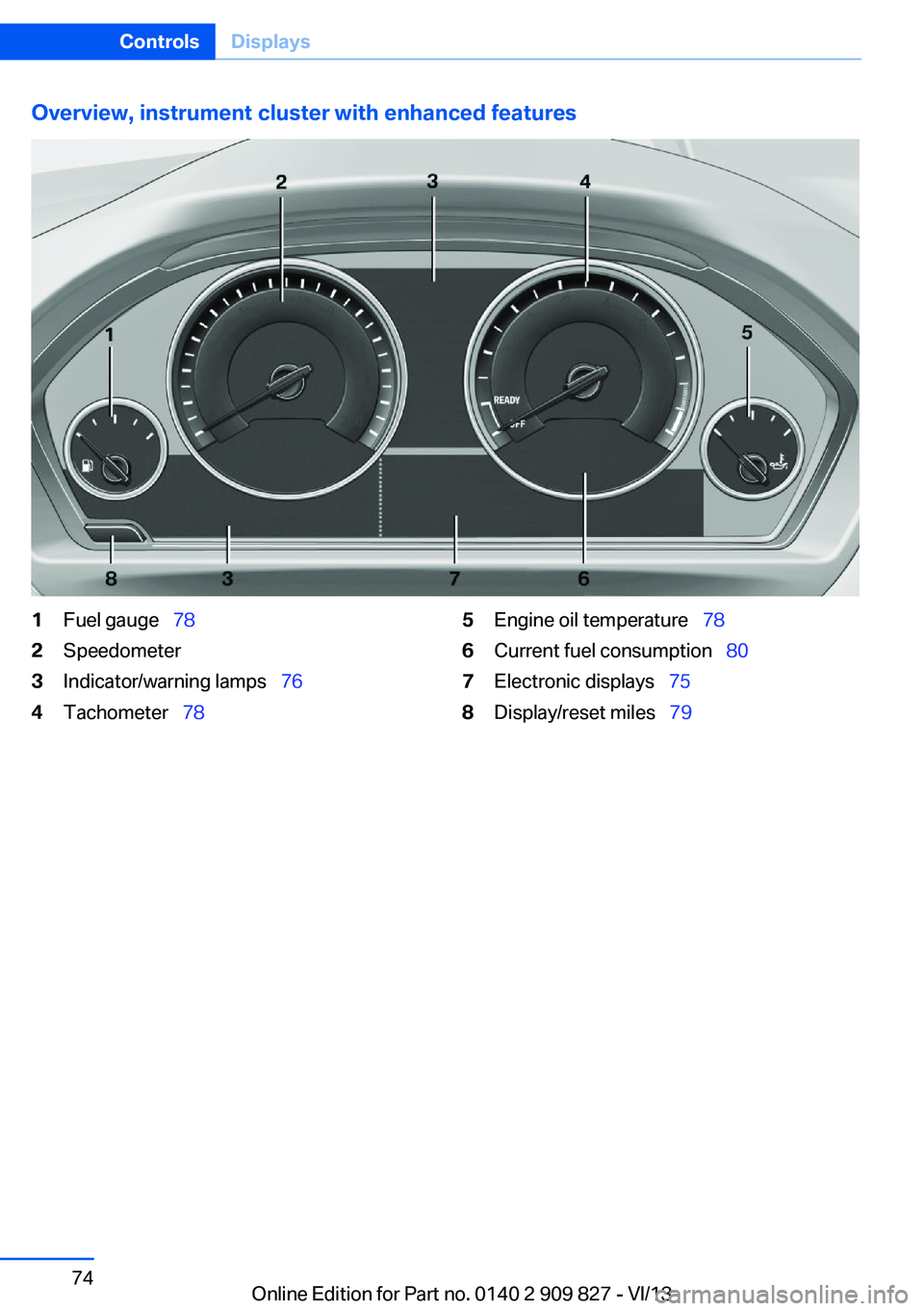
Overview, instrument cluster with enhanced features1Fuel gauge 782Speedometer3Indicator/warning lamps 764Tachometer 785Engine oil temperature 786Current fuel consumption 807Electronic displays 758Display/reset miles 79Seite 74ControlsDisplays74
Online Edition for Part no. 0140 2 909 827 - VI/13
Page 78 of 236
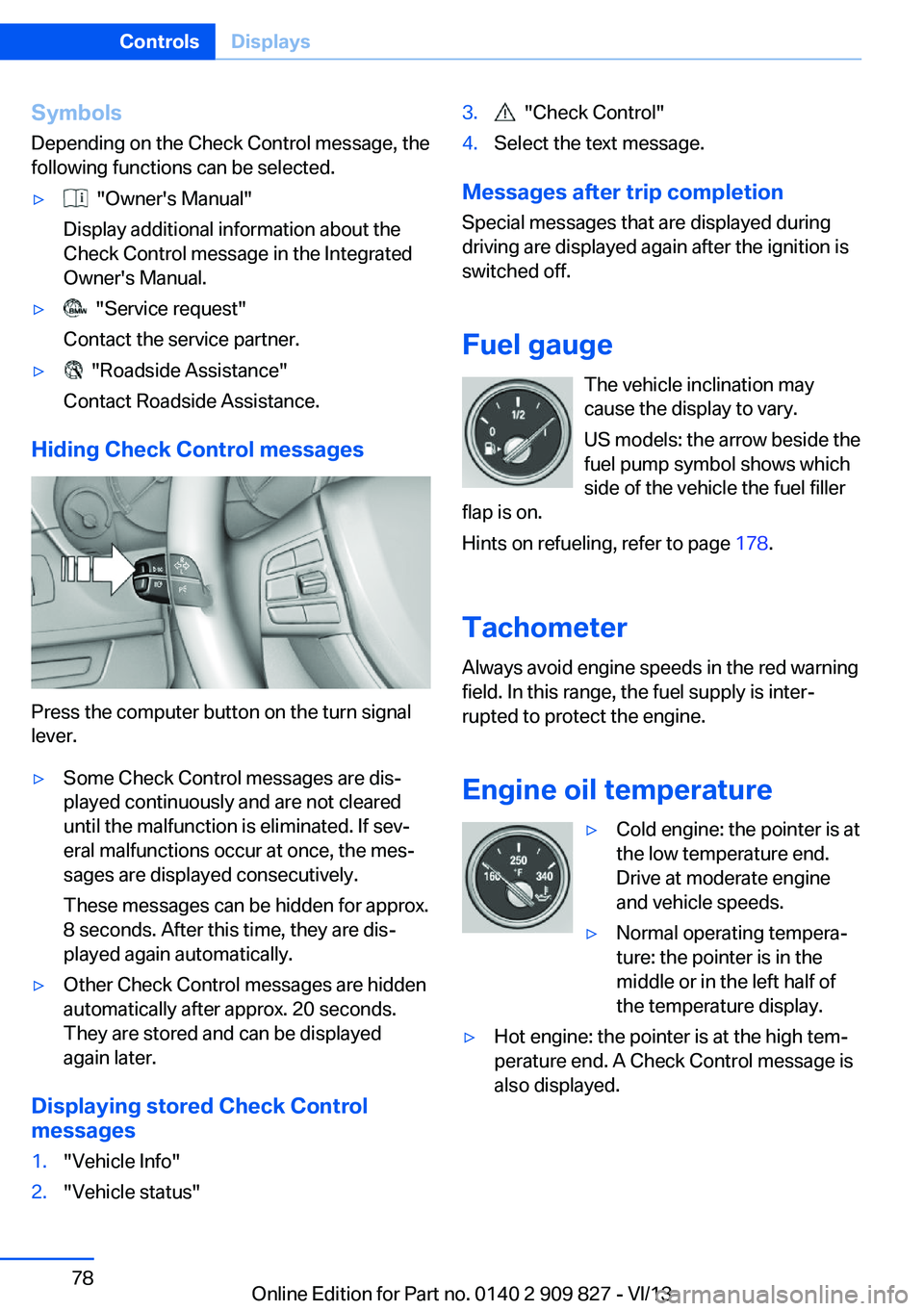
Symbols
Depending on the Check Control message, the
following functions can be selected.▷ "Owner's Manual"
Display additional information about the
Check Control message in the Integrated
Owner's Manual.▷ "Service request"
Contact the service partner.▷ "Roadside Assistance"
Contact Roadside Assistance.
Hiding Check Control messages
Press the computer button on the turn signal
lever.
▷Some Check Control messages are dis‐
played continuously and are not cleared
until the malfunction is eliminated. If sev‐
eral malfunctions occur at once, the mes‐
sages are displayed consecutively.
These messages can be hidden for approx.
8 seconds. After this time, they are dis‐
played again automatically.▷Other Check Control messages are hidden
automatically after approx. 20 seconds.
They are stored and can be displayed
again later.
Displaying stored Check Control
messages
1."Vehicle Info"2."Vehicle status"3. "Check Control"4.Select the text message.
Messages after trip completion
Special messages that are displayed during
driving are displayed again after the ignition is
switched off.
Fuel gauge The vehicle inclination may
cause the display to vary.
US models: the arrow beside the
fuel pump symbol shows which
side of the vehicle the fuel filler
flap is on.
Hints on refueling, refer to page 178.
Tachometer
Always avoid engine speeds in the red warning
field. In this range, the fuel supply is inter‐
rupted to protect the engine.
Engine oil temperature
▷Cold engine: the pointer is at
the low temperature end.
Drive at moderate engine
and vehicle speeds.▷Normal operating tempera‐
ture: the pointer is in the
middle or in the left half of
the temperature display.▷Hot engine: the pointer is at the high tem‐
perature end. A Check Control message is
also displayed.Seite 78ControlsDisplays78
Online Edition for Part no. 0140 2 909 827 - VI/13
Page 192 of 236
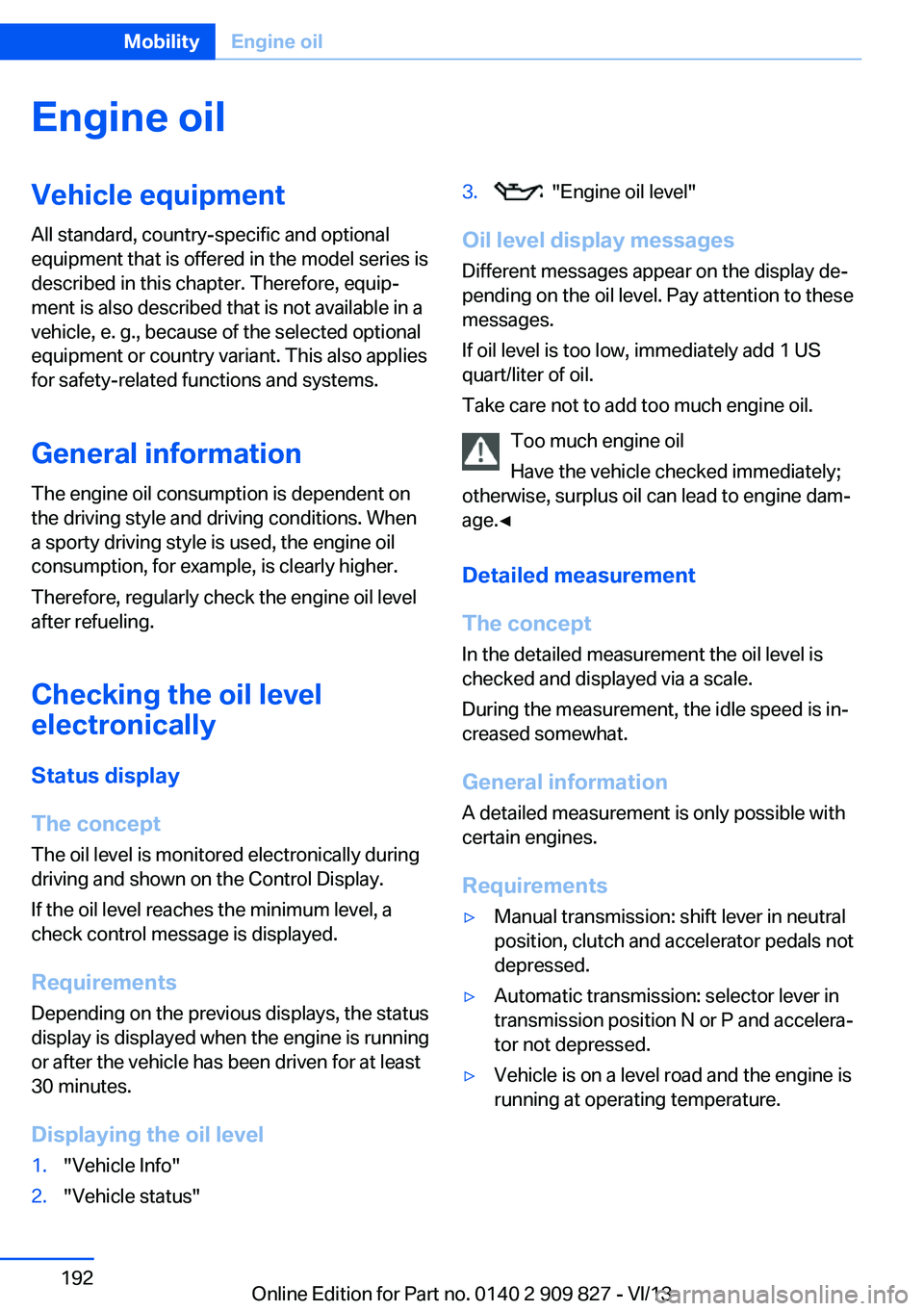
Engine oilVehicle equipment
All standard, country-specific and optional
equipment that is offered in the model series is
described in this chapter. Therefore, equip‐
ment is also described that is not available in a
vehicle, e. g., because of the selected optional
equipment or country variant. This also applies
for safety-related functions and systems.
General information The engine oil consumption is dependent on
the driving style and driving conditions. When
a sporty driving style is used, the engine oil
consumption, for example, is clearly higher.
Therefore, regularly check the engine oil level
after refueling.
Checking the oil level
electronically
Status display
The concept The oil level is monitored electronically during
driving and shown on the Control Display.
If the oil level reaches the minimum level, a
check control message is displayed.
Requirements Depending on the previous displays, the status
display is displayed when the engine is running
or after the vehicle has been driven for at least
30 minutes.
Displaying the oil level1."Vehicle Info"2."Vehicle status"3. "Engine oil level"
Oil level display messages
Different messages appear on the display de‐
pending on the oil level. Pay attention to these
messages.
If oil level is too low, immediately add 1 US
quart/liter of oil.
Take care not to add too much engine oil.
Too much engine oil
Have the vehicle checked immediately;
otherwise, surplus oil can lead to engine dam‐
age.◀
Detailed measurement
The concept
In the detailed measurement the oil level is
checked and displayed via a scale.
During the measurement, the idle speed is in‐
creased somewhat.
General information
A detailed measurement is only possible with
certain engines.
Requirements
▷Manual transmission: shift lever in neutral
position, clutch and accelerator pedals not
depressed.▷Automatic transmission: selector lever in
transmission position N or P and accelera‐
tor not depressed.▷Vehicle is on a level road and the engine is
running at operating temperature.Seite 192MobilityEngine oil192
Online Edition for Part no. 0140 2 909 827 - VI/13
Page 216 of 236
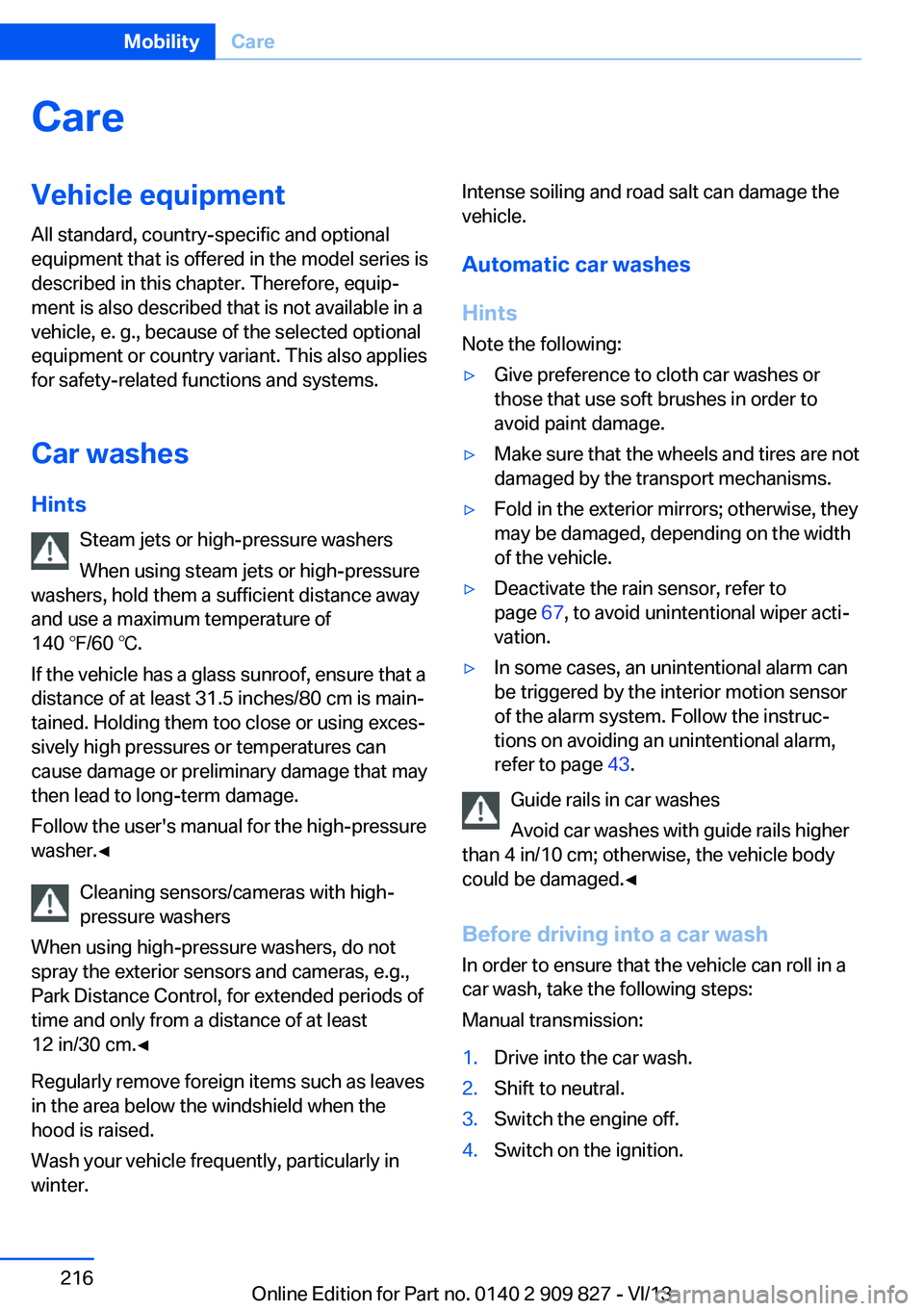
CareVehicle equipmentAll standard, country-specific and optional
equipment that is offered in the model series is
described in this chapter. Therefore, equip‐
ment is also described that is not available in a
vehicle, e. g., because of the selected optional
equipment or country variant. This also applies
for safety-related functions and systems.
Car washes Hints Steam jets or high-pressure washers
When using steam jets or high-pressure
washers, hold them a sufficient distance away and use a maximum temperature of
140 ℉/60 ℃.
If the vehicle has a glass sunroof, ensure that a distance of at least 31.5 inches/80 cm is main‐
tained. Holding them too close or using exces‐
sively high pressures or temperatures can
cause damage or preliminary damage that may
then lead to long-term damage.
Follow the user's manual for the high-pressure
washer.◀
Cleaning sensors/cameras with high-
pressure washers
When using high-pressure washers, do not
spray the exterior sensors and cameras, e.g., Park Distance Control, for extended periods of
time and only from a distance of at least
12 in/30 cm.◀
Regularly remove foreign items such as leaves
in the area below the windshield when the
hood is raised.
Wash your vehicle frequently, particularly in
winter.Intense soiling and road salt can damage the
vehicle.
Automatic car washes
Hints
Note the following:▷Give preference to cloth car washes or
those that use soft brushes in order to
avoid paint damage.▷Make sure that the wheels and tires are not
damaged by the transport mechanisms.▷Fold in the exterior mirrors; otherwise, they
may be damaged, depending on the width
of the vehicle.▷Deactivate the rain sensor, refer to
page 67, to avoid unintentional wiper acti‐
vation.▷In some cases, an unintentional alarm can
be triggered by the interior motion sensor
of the alarm system. Follow the instruc‐
tions on avoiding an unintentional alarm,
refer to page 43.
Guide rails in car washes
Avoid car washes with guide rails higher
than 4 in/10 cm; otherwise, the vehicle body
could be damaged.◀
Before driving into a car wash In order to ensure that the vehicle can roll in a
car wash, take the following steps:
Manual transmission:
1.Drive into the car wash.2.Shift to neutral.3.Switch the engine off.4.Switch on the ignition.Seite 216MobilityCare216
Online Edition for Part no. 0140 2 909 827 - VI/13
Page 228 of 236

Connecting electrical devi‐ces 153
Control Display 16
Control Display, settings 86
Controller 16, 17
Control systems, driving sta‐ bility 115
Convenient opening 36
Coolant 195
Coolant temperature 79
Cooling function 143, 145
Cooling, maximum 145
Cooling system 195
Corrosion on brake discs 166
Cruise control 126
Cruise control, active with Stop & Go 120
Cruising range 79
Cupholder 159
Current fuel consumption 80
D
Damage, tires 186
Damping control, dy‐ namic 116
Data, technical 222
Date 79
Daytime running lights 90
Defrosting, refer to defrosting the windows 143
Defrosting, refer to Windows, defrosting 146
Defrosting the windows 143
Dehumidifying, air 143
Destination distance 85
Digital clock 79
Digital compass 151
Dimensions 222
Dimmable exterior mirrors 55
Dimmable interior rearview mirror 55
Direction indicator, refer to Turn signals 66
Display, electronic, instru‐ ment cluster 75 Display in windshield 140
Display lighting, refer to In‐ strument lighting 92
Displays 73
Displays, cleaning 219
Disposal, coolant 195
Disposal, vehicle battery 207
Distance control, refer to PDC 128
Distance to destination 85
Divided screen view, split screen 21
Door lock, refer to Remote control 32
Drive-off assistant 119
Drive-off assistant, refer to DSC 115
Driver assistance, see Intelli‐ gent Safety 102
Driving Assistant, see Intelli‐ gent Safety 102
Driving experience switch 117
Driving instructions, breaking in 164
Driving mode 117
Driving notes, general 164
Driving stability control sys‐ tems 115
Driving tips 164
DSC Dynamic Stability Con‐ trol 115
DTC Dynamic Traction Con‐ trol 116
Dynamic Damping Con‐ trol 116
Dynamic Stability Control DSC 115
Dynamic Traction Control DTC 116
E
ECO PRO 171
ECO PRO Analyser 175
ECO PRO, bonus range 172 ECO PRO display 171
ECO PRO driving mode 171
ECO PRO mode 171
ECO PRO Tip - driving in‐ struction 173
EfficientDynamics 173
Electronic displays, instru‐ ment cluster 75
Electronic Stability Program ESP, refer to DSC 115
Emergency detection, remote control 33
Emergency release, door lock 37
Emergency release, fuel filler flap 178
Emergency Request 210
Emergency service, refer to Roadside Assistance 211
Emergency start function, en‐ gine start 33
Emergency unlocking, trunk lid 39
Energy Control 80
Energy recovery 80
Engine, automatic Start/Stop function 63
Engine, automatic switch- off 63
Engine compartment 190
Engine compartment, work‐ ing in 191
Engine coolant 195
Engine idling when driving, coasting 174
Engine oil 192
Engine oil, adding 193
Engine oil additives 193
Engine oil change 193
Engine oil filler neck 193
Engine oil temperature 78
Engine oil types, alterna‐ tive 193
Engine oil types, ap‐ proved 193 Seite 228ReferenceEverything from A to Z228
Online Edition for Part no. 0140 2 909 827 - VI/13
Page 229 of 236

Engine start during malfunc‐tion 33
Engine start, jump-start‐ ing 211
Engine start, refer to Starting the engine 62
Engine stop 62
Engine temperature 78
Entering a car wash 216
Equipment, interior 149
ESP Electronic Stability Pro‐ gram, refer to DSC 115
Exchanging wheels/tires 187
Exhaust system 165
Exterior mirror, automatic dimming feature 55
Exterior mirrors 54
External start 211
External temperature dis‐ play 79
External temperature warn‐ ing 79
Eyes for securing cargo 168
F
Failure message, refer to Check Control 76
False alarm, refer to Uninten‐ tional alarm 43
Fan, refer to Air flow 143, 146
Fault displays, refer to Check Control 76
Filler neck for engine oil 193
Fine wood, care 218
First aid kit 211
Fitting for towing, refer to Tow fitting 214
Flat tire, changing wheels 206
Flat Tire Monitor FTM 100
Flat tire, Tire Pressure Moni‐ tor TPM 97
Flat tire, warning lamp 98, 101 Flooding 165
Floor carpet, care 219
Floor mats, care 219
Fogged up windows 143
Fold down the rear seat back‐ rest, see Though-loading
system 155
Fold-out position, windshield wipers 68
Foot brake 165
Front airbags 94
Front fog lamps 92
Front fog lamps, front, bulb replacement 203
Front lamps 199
Front passenger airbags, au‐ tomatic deactivation 96
Front passenger airbags, indi‐ cator lamp 96
FTM Flat Tire Monitor 100
Fuel 180
Fuel cap 178
Fuel consumption, current 80
Fuel consumption, refer to Average fuel consump‐
tion 85
Fuel filler flap 178
Fuel gauge 78
Fuel quality 180
Fuel recommendation 180
Fuel, tank capacity 225
Fuse 208
G
Garage door opener, refer to Integrated universal remote
control 149
Gasoline 180
Gasoline quality 180
Gear change, automatic transmission 70
Gear shift indicator 81
General driving notes 164
Glass sunroof, powered 45
Glove compartment 157 Gross vehicle weight, ap‐
proved 223
Gross weight, permissible for trailer towing 223
H
Handbrake, refer to parking brake 65
Hand-held transmitter, alter‐ nating code 150
Hazard warning flashers 210
Head airbags 94
Headlamp control, auto‐ matic 90
Headlamp courtesy delay fea‐ ture 89
Headlamp flasher 66
Headlamp glass 199
Headlamps 199
Headlamps, care 217
Headlamp washer system 66
Headliner 15
Head restraints 47
Head restraints, front 52
Head-up Display 140
Head-up Display, care 219
Heavy cargo, stowing 168
Height, vehicle 222
High-beam Assistant 91
High beams 66
High beams/low beams, refer to High-beam Assistant 91
Hills 166
Hill start assistant, refer to Drive-off assistant 119
Hints 6
Holder for beverages 159
Homepage 6
Hood 191
Horn 12
Hotel function, trunk lid 39
Hot exhaust system 165
HUD Head-up Display 140
Hydroplaning 165 Seite 229Everything from A to ZReference229
Online Edition for Part no. 0140 2 909 827 - VI/13
Page 231 of 236
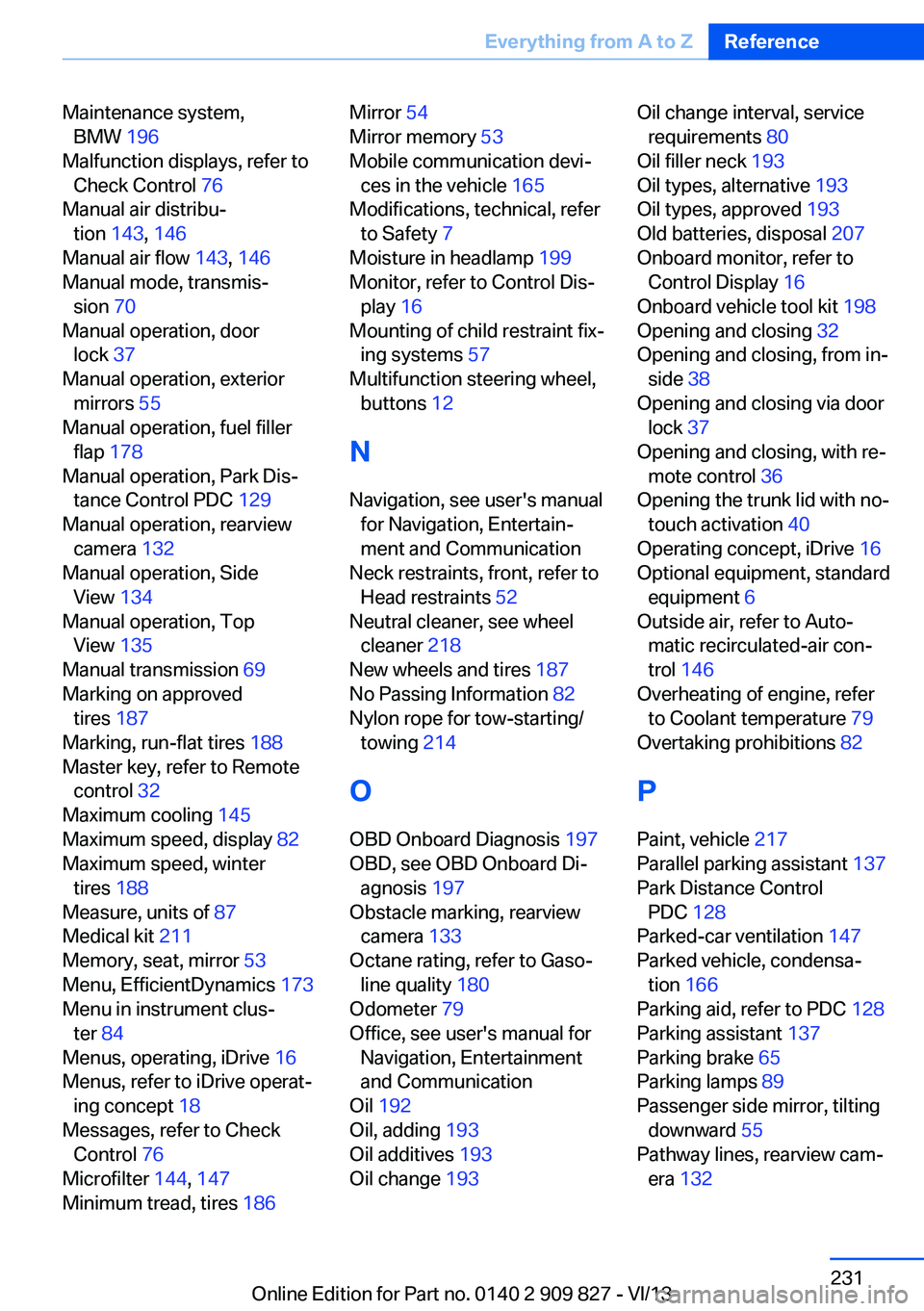
Maintenance system,BMW 196
Malfunction displays, refer to Check Control 76
Manual air distribu‐ tion 143, 146
Manual air flow 143, 146
Manual mode, transmis‐ sion 70
Manual operation, door lock 37
Manual operation, exterior mirrors 55
Manual operation, fuel filler flap 178
Manual operation, Park Dis‐ tance Control PDC 129
Manual operation, rearview camera 132
Manual operation, Side View 134
Manual operation, Top View 135
Manual transmission 69
Marking on approved tires 187
Marking, run-flat tires 188
Master key, refer to Remote control 32
Maximum cooling 145
Maximum speed, display 82
Maximum speed, winter tires 188
Measure, units of 87
Medical kit 211
Memory, seat, mirror 53
Menu, EfficientDynamics 173
Menu in instrument clus‐ ter 84
Menus, operating, iDrive 16
Menus, refer to iDrive operat‐ ing concept 18
Messages, refer to Check Control 76
Microfilter 144, 147
Minimum tread, tires 186 Mirror 54
Mirror memory 53
Mobile communication devi‐ ces in the vehicle 165
Modifications, technical, refer to Safety 7
Moisture in headlamp 199
Monitor, refer to Control Dis‐ play 16
Mounting of child restraint fix‐ ing systems 57
Multifunction steering wheel, buttons 12
N Navigation, see user's manual for Navigation, Entertain‐
ment and Communication
Neck restraints, front, refer to Head restraints 52
Neutral cleaner, see wheel cleaner 218
New wheels and tires 187
No Passing Information 82
Nylon rope for tow-starting/ towing 214
O OBD Onboard Diagnosis 197
OBD, see OBD Onboard Di‐ agnosis 197
Obstacle marking, rearview camera 133
Octane rating, refer to Gaso‐ line quality 180
Odometer 79
Office, see user's manual for Navigation, Entertainment
and Communication
Oil 192
Oil, adding 193
Oil additives 193
Oil change 193 Oil change interval, service
requirements 80
Oil filler neck 193
Oil types, alternative 193
Oil types, approved 193
Old batteries, disposal 207
Onboard monitor, refer to Control Display 16
Onboard vehicle tool kit 198
Opening and closing 32
Opening and closing, from in‐ side 38
Opening and closing via door lock 37
Opening and closing, with re‐ mote control 36
Opening the trunk lid with no- touch activation 40
Operating concept, iDrive 16
Optional equipment, standard equipment 6
Outside air, refer to Auto‐ matic recirculated-air con‐
trol 146
Overheating of engine, refer to Coolant temperature 79
Overtaking prohibitions 82
P Paint, vehicle 217
Parallel parking assistant 137
Park Distance Control PDC 128
Parked-car ventilation 147
Parked vehicle, condensa‐ tion 166
Parking aid, refer to PDC 128
Parking assistant 137
Parking brake 65
Parking lamps 89
Passenger side mirror, tilting downward 55
Pathway lines, rearview cam‐ era 132 Seite 231Everything from A to ZReference231
Online Edition for Part no. 0140 2 909 827 - VI/13